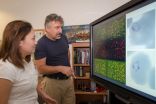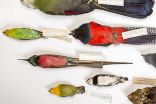(Press-News.org) CHAMPAIGN, Ill. - Where did the songbird get its song? What branch of the bird family tree is closer to the flamingo - the heron or the sparrow?
These questions seem simple, but are actually difficult for geneticists to answer. A new, sophisticated statistical technique developed by researchers at the University of Illinois and the University of Texas at Austin can help researchers construct more accurate species trees detailing the lineage of genes and the relationships between species.
The method, called statistical binning, was used in the Avian Phylogenetics Project, the subject of a Dec. 12 special issue of the journal Science.
"A species tree is a way of describing how a species evolved from a common ancestor," said study leader Tandy Warnow, Founder Professor of bioengineering and computer science at the University of Illinois. "Researchers use a species tree to do all sorts of things, like figure out when different traits came into being, and what triggered that trait evolution, and how those things may or may not have been triggered by environmental changes."
There are two main approaches to constructing a species tree from genomic data, Warnow said. One method, which has prevailed for decades, puts all the gene data together into one giant matrix and analyzes it to map the overall species tree. This is called concatenation. The difficulty with that approach is that individual genes often have different lineages, which can diverge greatly from each other and the species tree as a whole.
A second approach, the coalescent-based method, looks at the data for each gene and estimates gene trees for each trait. Then it combines all the trees together to create the overall species tree. While this approach is sound theoretically and statistically, it does not perform as well as expected in practice.
"We realized that the gene trees that are combined have error in them," Warnow said. "When the gene trees have error, then when you combine them you get a bad estimate of the species tree. So we needed to get better gene trees, and the question is, how do we do that?"
Statistical binning takes all the gene data and uses statistical optimization techniques to sort the genes into sets or "bins." The genes in each bin have trees that don't seem to have statistically significant differences. The data for each bin is combined into a "supergene" tree, and then the supergene trees are combined into an overall species tree.
"You can think of statistical binning as combining the best properties of the two dominant approaches," said Siavash Mirarab, graduate student at the University of Texas at Austin and first author of the paper detailing the statistical binning method. "Without this method, what people had to do was throw away data they didn't like. This approach allows you to use all the data you have and you don't have to throw away anything. We have a method that achieves that by grouping things together in a way that makes sense, statistically."
The researchers compared the species trees produced using the coalescent method with statistical binning to trees produced with concatenation or coalescence alone for several biological classes, such as birds, mammals, yeast and others. They found that adding the statistical binning process to the pipeline produced species trees that were better than the trees produced by either of the conventional methods.
"We sort the gene data in a sophisticated statistical way, but having done it we get better trees," Warnow said. "The result is significantly improved estimates of the gene trees, which gave us better estimates of the species tree and branch lengths, which helps you figure out when things happened. Everything was much more accurate."
Statistical binning allowed the Avian Phylogenetics Project to analyze more than 14,000 genes - one of the largest such projects yet published - and construct a large tree linking many different bird species. As it turns out, the flamingo is more closely related to the pigeon.
Warnow and Mirarab plan to continue to refine the statistical binning method and hope that it can add accuracy to many other similar studies.
"There's a large divide in the research community as to whether to use concatenation of a coalescent analyses. What we did was understand why the coalescent method didn't give good results and came up with a way of improving the input so that it could have good results. It's a way of bringing these two very divided communities into greater agreement with each other," Warnow said.
INFORMATION:
To reach Tandy Warnow, call 217-300-3087; email warnow@illinois.edu.
To reach Siavash Mirarab, email smirarab@cs.utexas.edu
The paper, "Statistical binning enables an accurate coalescent-based estimation of the avian tree," is available to members of the media from AAAS or scipak@aaas.org.
This news release is available in Spanish. 66 million years ago, the dinosaurs, as we think about them, became extinct, but certain reptiles and birds survived this mass extinction. The birds that survived experienced rapid evolution and diversification. Until now, explaining the family tree of modern birds has been a difficult and controversial subject amongst scientists. Thanks to the research of an international consortium involving researchers from the Centre for Genomic Regulation in Barcelona, we now have new clues about this evolution and further information ...
FORT LAUDERDALE-DAVIE, Fla. - We all know that ducks, crows, falcons and egrets are birds. A group of scientists, however, wanted to dig deeper and unlock more about how these animals are related genetically. The idea was to investigate how modern species of birds emerged and evolved after the dinosaurs disappeared from the earth. This research included work from Stephen O'Brien, Ph.D., a professor at NSU's Oceanographic Center whose main focus in genomics.
Now findings from this research are being announced in several scientific publications, including Science magazine, ...
A Texas Tech University biologist led a team of more than 50 scientists who mapped the genomes of three crocodilians.
By mapping these genomes, scientists may better understand the evolution of birds, which are the toothy predators' closest living relatives, said David Ray, an associate professor of biology. The team completed genomes of a crocodile, an alligator and a true gharial to complete the genomic family portrait.
Their research, largely funded by the National Science Foundation, will appear Friday (Dec. 12) in the peer-reviewed journal, Science.
"One of the ...
Scientists from Nanyang Technological University (NTU) have discovered exactly how the malaria parasite is developing resistance towards the most important front-line drugs used to treat the disease.
Malaria is a mosquito-borne parasite which affects over 60 million people worldwide and in serious cases, can be fatal. There is currently no viable vaccine for malaria while antimalarial drugs and prophylaxis are losing its efficacy with increasing drug resistance.
NTU Associate Professor Zbynek Bozdech, who led an international research team from 11 different countries, ...
The first findings of the Avian Phylogenomics Consortium are being reported nearly simultaneously in 28 papers -- eight papers in a Dec. 12 special issue of Science and 20 more in Genome Biology, GigaScience and other journals. The full set of papers in Science and other journals can be accessed at avian.genomics.cn
Scientists already knew that the birds who survived the mass extinction experienced a rapid burst of evolution. But the family tree of modern birds has confused biologists for centuries and the molecular details of how birds arrived at the spectacular biodiversity ...
New research from the University of Kent suggests that chickens and turkeys have experienced fewer gross genomic changes than other birds as they evolved from their dinosaur ancestor.
Professor Darren Griffin and a team at the University's School of Biosciences have conducted research that suggests that chromosomes of the chicken and turkey lineage have undergone the fewest number of changes compared to their ancient avian ancestor, thought to be a feathered dinosaur.
The Kent research is part of a study by a consortium of leading scientists into avian or bird genomes, ...
An international team of scientists has completed the largest whole genome study of a single class of animals to date. To map the tree of life for birds, the team sequenced, assembled and compared full genomes of 48 bird species representing all major branches of modern birds including ostrich, hummingbird, crow, duck, falcon, parrot, crane, ibis, woodpecker and eagle species. The researchers have been working on this ambitious genetic tree of life, or phylogeny, project for four years.
As part of the Avian Phylogenomics Consortium -- comprised of more than 200 scientists ...
NEW YORK, NY (December 11, 2014) Growing resistance to malaria drugs in Southeast Asia is caused by a single mutated gene inside the disease-causing Plasmodium falciparum parasite, according to a study led by David Fidock, PhD, professor of microbiology & immunology and of medical sciences (in medicine) at Columbia University Medical Center.
This finding provides public health officials around the world with a way to look for pockets of emerging resistance and potentially eliminate them before they spread.
Though malaria deaths have dropped by 30 percent worldwide since ...
Targeted therapies are a growing and groundbreaking field in cancer care in which drugs or other substances are designed to interfere with genes or molecules that control the growth and survival of cancer cells. Now, scientists at Virginia Commonwealth University Massey Cancer Center and VCU Institute of Molecular Medicine (VIMM) have identified a novel interaction between a microRNA and a gene that could lead to new therapies for the most common and deadly form of brain tumor, malignant glioma.
In a study recently published in the journal Neuro-Oncology, a team of scientists ...
Advances in treatment for human immunodeficiency virus (HIV) have made it possible for people with HIV to survive much longer. As they age, however, many experience impaired thinking, memory loss, mood swings and other evidence of impaired mental function.
To stop these changes, scientists have to learn what is causing them. One possibility researchers are considering is that long-term infections with other pathogens, common in HIV-positive patients, are affecting the brain. But a new study has eliminated one of their prime suspects: the hepatitis C virus, which infects ...



